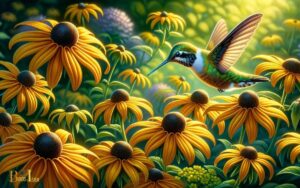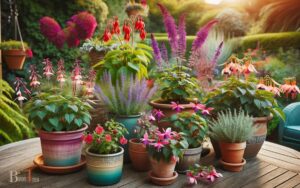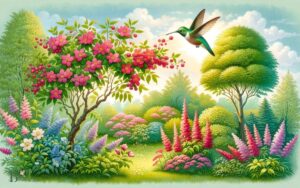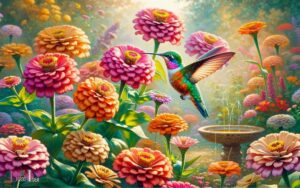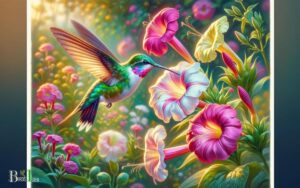Will Artificial Flowers Attract Hummingbirds? No!
No, artificial flowers do not attract hummingbirds as they do not provide nectar, which is the primary reason these birds visit flowers.
Hummingbirds are attracted to the color and shape of flowers that suggest nectar may be available, but upon closer inspection, they will not linger at artificial blooms that offer no nutritional value.
Hummingbirds are attracted to vividly colored flowers, especially in shades of red, pink, and orange, because these colors often signal a rich source of nectar. However, their attraction is not solely based on color.
They use sight and sense of smell to locate flowers abundant in nectar. Artificial flowers, though they may mimic the visual appeal of real flowers, lack the scent and nectar that hummingbirds seek for sustenance.
Since artificial flowers do not fulfill the nutritional needs of these birds, they typically do not serve as a reliable method to attract them.
Gardeners seeking to attract hummingbirds should consider planting nectar-rich flowers or providing a hummingbird feeder with a sugar solution.
For avid bird watchers hoping to attract hummingbirds, it’s best to stick with planting nectar-rich flowers or using specialized feeders filled with sugar water.
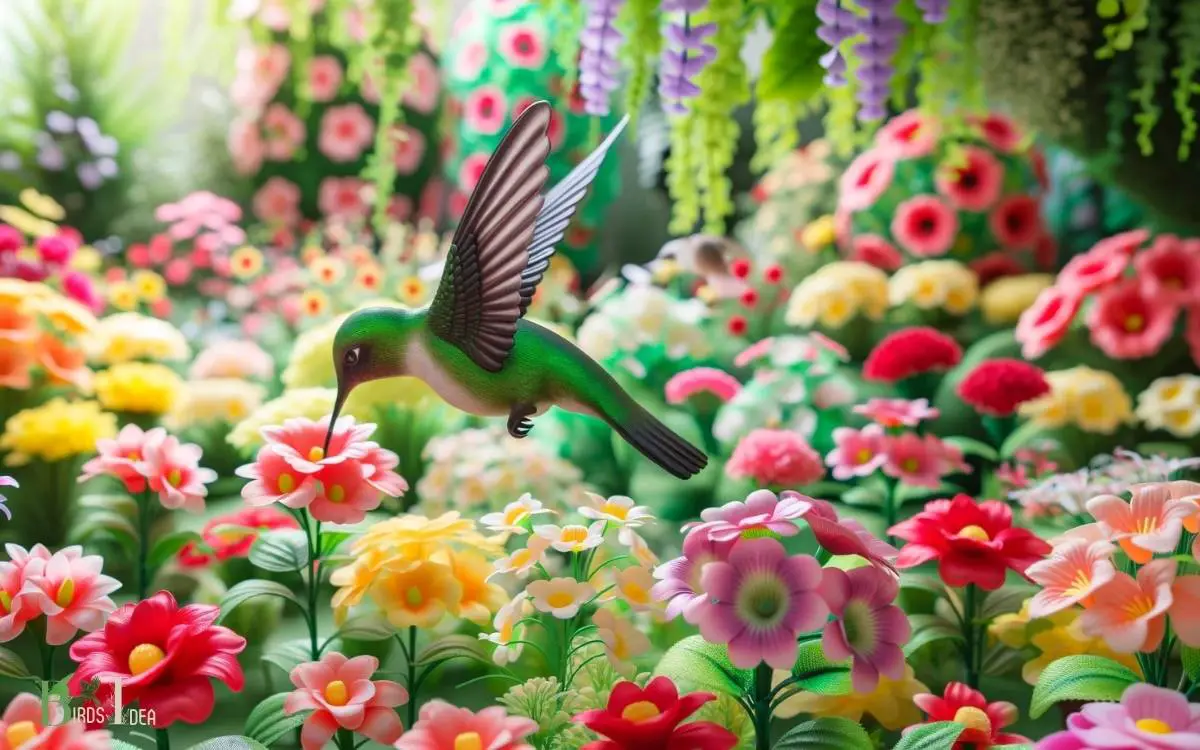
Key Takeaway
Factors Affecting Hummingbird Attraction
Why do certain factors affect hummingbird attraction to flowers? Hummingbird attraction to flowers is influenced by multiple factors. One key factor is the color of the flowers.
Hummingbirds are attracted to bright and vivid colors, particularly red, orange, and pink. These colors signal to the birds that the flowers are a potential source of nectar. Another important factor is the shape of the flower.
Hummingbirds have long, slender bills and are drawn to tubular-shaped flowers that allow them to access the nectar with ease. The amount of nectar produced by the flowers also plays a role in attracting hummingbirds.
Flowers that produce more nectar are likely to be more appealing to these birds. Additionally, the placement of the flowers in relation to light and wind can affect hummingbird attraction, as they prefer flowers that are easily accessible and not obstructed by other plants.
Characteristics of Artificial Flowers
Artificial flowers come in a variety of shapes, sizes, and colors, all of which can affect their appeal to hummingbirds. The visual appearance of artificial flowers and their ability to mimic real flowers can play a significant role in attracting hummingbirds.
Additionally, the longevity and maintenance of artificial flowers may impact their suitability for attracting and sustaining hummingbird visits.
Hummingbird Attraction to Artificial
Hummingbirds are attracted to specific characteristics of artificial flowers, such as color and shape. These birds are known for their affinity towards bright, vivid colors, particularly red, orange, and pink.
When it comes to artificial flowers, using realistic color patterns and imitating the natural hues of real flowers can significantly increase their attractiveness to hummingbirds.
Additionally, the shape of artificial flowers plays a crucial role in attracting these birds. Hummingbirds are drawn to tubular-shaped flowers, as they are adapted to feed on the nectar found in such blossoms.
Therefore, artificial flowers with elongated, tubular shapes can effectively mimic the natural floral structures that hummingbirds are naturally inclined to visit.
Understanding these characteristics of artificial flowers can aid in creating an environment that appeals to hummingbirds.
Visual Appeal for Hummingbirds
The visual appeal of artificial flowers plays a crucial role in attracting hummingbirds to a garden or outdoor space.
When considering the characteristics of artificial flowers that are visually appealing to hummingbirds, the following factors should be taken into account:
- Bright and vivid colors: Hummingbirds are attracted to vibrant hues such as red, orange, and pink, so artificial flowers in these shades are more likely to catch their attention.
- Mimicking natural patterns: Artificial flowers that closely resemble the shape and pattern of real flowers can effectively attract hummingbirds, as they recognize familiar feeding sources.
- UV reflectance: Some artificial flowers are designed with ultraviolet reflectance to mimic the way natural flowers signal to hummingbirds. Incorporating this feature can enhance their visual appeal to these birds.
Longevity and Maintenance
Using an indefinite pronoun, it is important to consider the longevity and maintenance of artificial flowers when attracting hummingbirds.
Artificial flowers offer several advantages in terms of longevity and maintenance. They do not wither or require watering, providing a consistent food source for hummingbirds.
Additionally, artificial flowers are low maintenance, requiring only occasional cleaning to remove dust or debris.
However, it is essential to choose high-quality artificial flowers that closely resemble real flowers in color and shape to effectively attract hummingbirds.
| Characteristics | Description |
|---|---|
| Longevity | Artificial flowers do not wither and provide a consistent food source. |
| Maintenance | Low maintenance, requiring occasional cleaning. |
| Material | Choose high-quality flowers resembling real ones. |
| Appearance | Color and shape should closely resemble real flowers. |
Color and Nectar Mimicry
Artificial flowers that accurately mimic the color and nectar of real flowers can effectively attract hummingbirds to a garden.
Hummingbirds are attracted to bright and vibrant colors, such as reds, pinks, and oranges, as these hues signal a high nectar content in real flowers.
Artificial flowers that replicate these colors can be just as appealing to hummingbirds. Similarly, the nectar mimicry in artificial flowers can be achieved by using sweet and sugary solutions that closely resemble the nectar found in real flowers.
Additionally, the shape and structure of artificial flowers can play a crucial role in attracting hummingbirds, as they are naturally drawn to tubular shapes that mimic the flowers they feed from in nature.
These factors combined make it possible for artificial flowers to effectively attract hummingbirds to a garden.
Pros of Using Artificial Flowers
Many gardeners find that using artificial flowers effectively attracts hummingbirds due to their vibrant colors and nectar mimicry.
The vibrant colors of artificial flowers, such as red, orange, and pink, mimic the natural flowers that hummingbirds are attracted to.
Additionally, some artificial flowers are designed to resemble the shape and texture of real flowers, providing a familiar feeding experience for hummingbirds.
Moreover, artificial flowers require minimal maintenance compared to real flowers, as they do not require watering, pruning, or deadheading.
This makes them a convenient option for attracting hummingbirds, especially in regions with harsh weather conditions or poor soil quality.
Pros of Using Artificial Flowers
- Vibrant Colors
- Nectar Mimicry
- Low Maintenance
- Weather Resistant
Cons of Using Artificial Flowers
Unfortunately, some gardeners may find that using artificial flowers does not always effectively attract hummingbirds.
When considering the cons of using artificial flowers to attract hummingbirds, several factors should be taken into account:
- Lack of nectar: Artificial flowers do not provide the nectar that hummingbirds need for sustenance, which may lead to the birds seeking out real flowers elsewhere.
- Lack of fragrance: Hummingbirds are attracted to the scent of real flowers, which artificial flowers do not emit, potentially making them less appealing to the birds.
- Durability: Artificial flowers may not withstand the elements as well as real flowers, leading to a shorter lifespan and potentially becoming less visually appealing over time.
These factors highlight the limitations of using artificial flowers to attract hummingbirds and emphasize the importance of considering natural alternatives.
Tips for Using Artificial Flowers
Artificial flowers can be a valuable resource for attracting hummingbirds with the right approach. When selecting artificial flowers, it is essential to choose options that closely resemble the natural blooms hummingbirds are attracted to.
Color and nectar imitation are crucial factors in mimicking the real flowers, while proper maintenance ensures longevity and effectiveness in attracting hummingbirds.
Hummingbird-Friendly Artificial Options
Hummingbirds occasionally visit gardens with artificial flowers, so it’s important to choose options that mimic the real ones to attract them effectively.
When selecting artificial flowers for a hummingbird-friendly garden, consider the following tips:
- Natural Shape and Movement: Opt for artificial flowers that closely resemble the natural shape and movement of real flowers when swaying in the breeze. This can help attract hummingbirds, as they are instinctively drawn to the familiar motion.
- Realistic Colors: Choose artificial flowers with vibrant, true-to-life colors that closely resemble those found in the nectar-producing flowers hummingbirds are naturally attracted to.
- UV-Reflective Materials: Select artificial flowers made from UV-reflective materials, as many real flowers have ultraviolet patterns that are visible to hummingbirds and guide them to the nectar source.
These considerations can significantly enhance the likelihood of attracting hummingbirds to artificial flowers in a garden setting.
Color and Nectar Imitation
When selecting artificial flowers for a hummingbird-friendly garden, it’s essential to focus on accurately imitating the colors and nectar of real flowers. Hummingbirds are attracted to bright, vivid colors such as red, orange, and pink.
Therefore, when choosing artificial flowers, opt for those that closely resemble the colors of the nectar-rich blooms that hummingbirds naturally feed on.
Additionally, it’s crucial to ensure that the artificial flowers mimic the shape and structure of real flowers to provide a familiar feeding experience for the hummingbirds.
Moreover, imitating the nectar of real flowers is vital. Some artificial flowers come with reservoirs that can be filled with sugar water, effectively imitating the nectar of real flowers and providing a vital energy source for the hummingbirds.
By carefully selecting artificial flowers that accurately imitate the colors and nectar of real flowers, one can create a welcoming environment for hummingbirds in their garden.
As the color and nectar imitation are crucial for attracting hummingbirds, it’s also important to understand maintenance tips for ensuring the longevity of artificial flowers.
Maintenance Tips for Longevity
How can one effectively maintain the longevity of artificial flowers to ensure their continued attractiveness to hummingbirds?
To ensure the prolonged attractiveness of artificial flowers to hummingbirds, it is essential to follow specific maintenance tips:
- Cleaning: Regularly clean the artificial flowers to remove dust, pollen, and any debris that may accumulate on the surface. This can be done using a soft brush or gentle air blow.
- UV Protection: Place the artificial flowers away from direct sunlight to prevent color fading or material degradation due to UV exposure.
- Repairs: Inspect the artificial flowers routinely for any damage or wear and tear. Repair any loose petals, stems, or other parts to maintain their realistic appearance and functionality.
Natural Vs. Artificial Habitat
Artificial habitats are occasionally used by hummingbirds as they search for nectar sources. However, natural habitats still reign supreme in attracting these tiny, agile birds.
Natural habitats provide a diverse range of nectar-producing flowers, insects, and nesting materials that support the complex needs of hummingbirds.
In contrast, artificial habitats, such as feeders and synthetic flowers, may offer limited resources and fail to mimic the complexity of natural environments.
While hummingbirds may visit artificial habitats for quick nectar access, they rely on natural habitats for essential sustenance and nesting.
It is crucial for conservation efforts to prioritize the preservation and restoration of natural habitats to ensure the long-term survival and thriving of hummingbird populations.
Understanding the nuanced differences between natural and artificial habitats is vital in creating sustainable environments for these remarkable birds.
Creating a Hummingbird-Friendly Environment
Creating a hummingbird-friendly environment involves providing a diverse range of nectar-producing flowers and nesting materials to support the complex needs of these agile birds.
- Selecting Nectar-Rich Flowers: Hummingbirds are attracted to tubular-shaped flowers with bright colors such as red, orange, and pink. Some suitable flower choices include bee balm, trumpet vine, and salvia.
- Sustainable Gardening Practices: Avoiding pesticides and opting for organic fertilizers helps to maintain a healthy environment for hummingbirds.
- Strategic Placement of Feeders: Placing nectar feeders in shaded areas can prevent the nectar from spoiling too quickly.
Conclusion
While artificial flowers may mimic the appearance of natural flowers, they are unlikely to attract hummingbirds due to their lack of nectar and natural characteristics.
Hummingbirds are highly specialized in their feeding habits and are attracted to the vibrant colors and nectar-rich blooms of natural flowers.
To create a hummingbird-friendly environment, it is best to focus on cultivating a variety of native flowers and providing natural sources of nectar.
The sight of a hummingbird feeding on a vibrant, nectar-filled flower is a mesmerizing spectacle that cannot be replicated by artificial substitutes.

